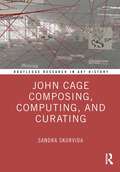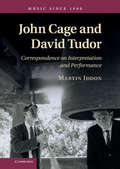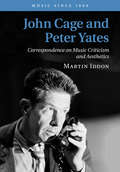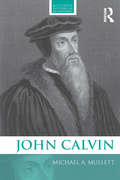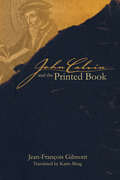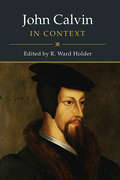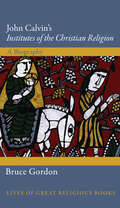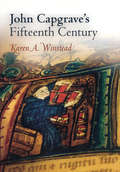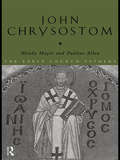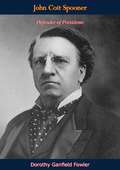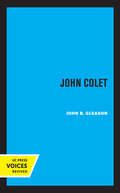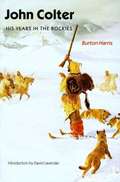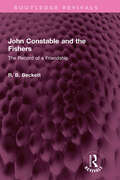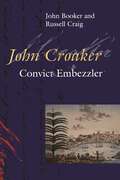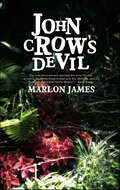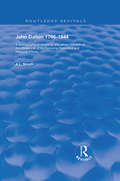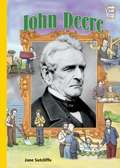- Table View
- List View
John Cage Composing, Computing, and Curating (Routledge Research in Art History)
by Sandra SkurvidaThis study reassesses Cage’s multifaceted practice from a transdisciplinary perspective, using text as a premise for his musical, visual, lingual, and museal compositions.In his compositions, John Cage opened the structures of music, language, and the museum to change perpetuated by chance operations. His correspondences across history with an extended circle of creators, including Erik Satie, Marcel Duchamp, and Henry David Thoreau, among many others, erased single-minded authorship via methodical processing of source material. Foreshadowing ecological recycling, Cage’s late compositions for museum opened perspectives for posthuman mediation in curating and contemporary art. He conceived of anarchy as the coexistence of mutually aiding yet autonomous self-determinate entities. This book introduces Cage to the twenty-first century as a composer whose work intersects different temporalities and modes of being, the past and the present, the human and the non-human, and the individual and the communal.The book will be of interest to scholars of art history, music, curatorial studies, and museum studies.
John Cage and David Tudor
by Martin IddonJohn Cage is best known for his indeterminate music, which leaves a significant level of creative decision-making in the hands of the performer. But how much licence did Cage allow? Martin Iddon's book is the first volume to collect the complete extant correspondence between the composer and pianist David Tudor, one of Cage's most provocative and significant musical collaborators. The book presents their partnership from working together in New York in the early 1950s, through periods on tour in Europe, until the late stages of their work from the 1960s onwards, carried out almost exclusively within the frame of the Merce Cunningham Dance Company. Tackling the question of how much creative flexibility Tudor was granted, Iddon includes detailed examples of the ways in which Tudor realised Cage's work, especially focusing on Music of Changes to Variations II, to show how composer and pianist influenced one another's methods and styles.
John Cage and Peter Yates: Correspondence on Music Criticism and Aesthetics (Music since 1900)
by Martin IddonThe correspondence between composer John Cage and Peter Yates represents the third and final part of Cage's most significant exchanges of letters, following those with Pierre Boulez and with David Tudor. Martin Iddon's book is the first volume to collect the complete extant correspondence with his critical friend, thus completing the 'trilogy' of Cage correspondence published by Cambridge. By bringing together more than 100 letters, beginning in 1940 and continuing until 1971, Iddon reveals the dialogue within which many of Cage's ideas were first forged and informed, with particular focus on his developing attitudes to music criticism and aesthetics. The correspondence with Yates represents precisely, in alignment with Cage's fastidious neatness, the part of his letter writing in which he engages most directly with the last part of his famous tricolon, 'composing's one thing, performing's another, listening's a third'.
John Calvin (Routledge Historical Biographies)
by Michael MullettJohn Calvin (1509-1564) is one of the most important figures in religious history. Sitting on the cusp of the medieval and early modern world, he was centre stage during the Reformation. In this new biography, Michael Mullett introduces us to this most important figure, tying his life together with that of Martin Luther, but also valuing his individual contribution and influence. From what Calvin himself described as ‘humble beginnings’, he became one of the most influential theologians of the Protestant Reformation. The influence of his teachings and the development of Christian theology into what was to become known as Calvinism, swept across Europe, reinforcing the Reformation’s radical break from the Catholic Church. John Calvin was ‘a mighty and formidable man, able to achieve the vast amount he did because of his unbending conviction of his rightness’. Michael Mullett explores the significant influences on Calvin and his work, and the relationships that he formed along his reforming path. Looking not only at the impact of Calvin throughout the early modern period and the importance of his work to contemporaries, Michael Mullett also assesses the impact that Calvin’s works have had in shaping the modern world, and the relevance that they still have today.
John Calvin and the Printed Book (Sixteenth Century Essays & Studies #72)
by Jean-François GilmontJohn Calvin made a significant contribution to the world of early modern printing. Jean-François Gilmont, one of the foremost experts in the field, has thoroughly researched and presented all aspects of John Calvin's interaction with books—from the authors he read, to the works he wrote, to his relationships with the printing and publishing world of the sixteenth century. Originally in French, Karin Maag makes Gilmont's research available in this English translation.
John Calvin and the Printed Book (Sixteenth Century Essays & Studies)
by Jean-François GilmontJohn Calvin made a significant contribution to the world of early modern printing. Jean-François Gilmont, one of the foremost experts in the field, has thoroughly researched and presented all aspects of John Calvin's interaction with books—from the authors he read, to the works he wrote, to his relationships with the printing and publishing world of the sixteenth century. Originally in French, Karin Maag makes Gilmont's research available in this English translation.
John Calvin in Context
by R. Ward HolderJohn Calvin in Context offers a comprehensive overview of Calvin's world. Including essays from social, cultural, feminist, and intellectual historians, each specially commissioned for this volume, the book considers the various early modern contexts in which Calvin worked and wrote. It captures his concerns for Northern humanism, his deep involvement in the politics of Geneva, his relationships with contemporaries, and the polemic necessities of responding to developments in Rome and other Protestant sects, notably Lutheran and Anabaptist. The volume also explores Calvin's tasks as a pastor and doctor of the church, who was constantly explicating the text of scripture and applying it to the context of sixteenth-century Geneva, as well as the reception of his role in the Reformation and beyond. Demonstrating the complexity of the world in which Calvin lived, John Calvin in Context serves as an essential research tool for scholars and students of early modern Europe.
John Calvin's "Institutes of the Christian Religion": A Biography
by Bruce GordonJohn Calvin's Institutes of the Christian Religion is a defining book of the Reformation and a pillar of Protestant theology. First published in Latin in 1536 and in Calvin's native French in 1541, the Institutes argues for the majesty of God and for justification by faith alone. The book decisively shaped Calvinism as a major religious and intellectual force in Europe and throughout the world. Here, Bruce Gordon provides an essential biography of Calvin's influential and enduring theological masterpiece, tracing the diverse ways it has been read and interpreted from Calvin's time to today.Gordon explores the origins and character of the Institutes, looking closely at its theological and historical roots, and explaining how it evolved through numerous editions to become a complete summary of Reformation doctrine. He shows how the development of the book reflected the evolving thought of Calvin, who instilled in the work a restlessness that reflected his understanding of the Christian life as a journey to God. Following Calvin's death in 1564, the Institutes continued to be reprinted, reedited, and reworked through the centuries. Gordon describes how it has been used in radically different ways, such as in South Africa, where it was invoked both to defend and attack the horror of apartheid. He examines its vexed relationship with the historical Calvin--a figure both revered and despised--and charts its robust and contentious reception history, taking readers from the Puritans and Voltaire to YouTube, the novels of Marilynne Robinson, and to China and Africa, where the Institutes continues to find new audiences today.
John Calvin: A Pilgrim's Life
by Herman J. SelderhuisThere are many biographies of John Calvin, the theologian--some villifying him and others extolling his virtues--but few that reveal John Calvin, the man. Professor and renowned Reformation historian Herman Selderhuis has written this book to bring Calvin near to the reader, showing him as a man who had an impressive impact on the development of the Western world, but who was first of all a believer struggling with God and with the way God governed both the world and his own life. Selderhuis draws on Calvin's own publications and commentary on the biblical figures with whom he strongly identified to describe his theology in the context of his personal development. Throughout we see a person who found himself alone at many of the decisive moments of his life--a fact that echoed through Calvin's subsequent sermons and commentaries. Selderhuis's unique and compelling look at John Calvin, with all of his merits and foibles, ultimately discloses a man who could not find himself at home in the world in which he lived.
John Capgrave's Fifteenth Century
by Karen A. WinsteadBritain of the fifteenth century was rife with social change, religious dissent, and political upheaval. Amid this ferment lived John Capgrave--Austin friar, doctor of theology, leading figure in East Anglian society, and noted author. Nowhere are the tensions and anxieties of this critical period, spanning the close of the medieval and the dawn of early modern eras, more eloquently conveyed than in Capgrave's works. John Capgrave's Fifteenth Century is the first book to explore the major themes of Capgrave's writings and to relate those themes to fifteenth-century political and cultural debates. Focusing on Capgrave's later works, especially those in English and addressed to lay audiences, it teases out thematic threads that are closely interwoven in Capgrave's Middle English oeuvre: piety, intellectualism, gender, and social responsibility. It refutes the still-prevalent view of Capgrave as a religious and political reactionary and shows, rather, that he used traditional genres to promote his own independent viewpoint on some of the most pressing controversies of his day, including debates over vernacular theology, orthodoxy and dissent, lay (and particularly female) spirituality, and the state of the kingdom under Henry VI.The book situates Capgrave as a figure both in the vibrant literary culture of East Anglia and in European intellectual history. John Capgrave's Fifteenth Century offers a fresh view of orthodoxy and dissent in late medieval England and will interest students of hagiography, religious and cultural history, and Lancastrian politics and society.
John Chapman: Planter And Pioneer (Paperback) Copyright 2016
by Ron FridellJohn Chapman, also known as, Johnny Appleseed, embarks on a wilderness journey, planting apple seeds.
John Chrysostom: New Approaches, New Perspectives (The Early Church Fathers #1)
by Pauline Allen Wendy MayerFirst published in 1999. Routledge is an imprint of Taylor & Francis, an informa company.
John Coit Spooner: Defender of Presidents
by Dorothy Ganfield FowlerAUTHENTIC STORY IN THE LORE OF THE AMERICAN SENATE—THE SAGA OF “THE FOUR,” WHO DOMINATED THAT BODY AROUND THE TURN OF THE CENTURY.Spooner was a brilliant orator who rose from a career as a railroad road solicitor to a political role here defined in the sub title, as “Defender of Presidents.” He had represented powerful interests before the Wisconsin legislature and in Washington and early story includes documented records of the rise of great railroad and lumber combines. The shift of public favor from the fabulous tycoons in the era of the muckrakers posed little threat to the short, powerful, prudent man who knew both politics and law.After a term in the Senate (1885-1888), he returned to law and party politics, and concentrated for a time on mending his personal finances. Then, with the incoming Republican tide, he was returned to the Senate after 1893 and was involved in every important political, legal and economic scramble of the growing nation. His wife detested living in Washington, and reluctantly he declined McKinley’s appointment as Attorney General. Hated by LaFollette, was close to Theodore Roosevelt, although some of his political associates viewed the doubtable President with suspicion.Before his death in 1919, Spooner returned to private life and amassed a small fortune in real estate and stock speculation. Throughout his years of public service, he was regarded as a vigorous and efficient statesman, but the reform drives that followed have nearly obliterated his memory, even in his home state.This book fills a gap in American political history, and students of the subject will find the present volume invaluable.
John Colet
by John B. GleasonThis title is part of UC Press's Voices Revived program, which commemorates University of California Press’s mission to seek out and cultivate the brightest minds and give them voice, reach, and impact. Drawing on a backlist dating to 1893, Voices Revived makes high-quality, peer-reviewed scholarship accessible once again using print-on-demand technology. This title was originally published in 1989.
John Colter: His Years in the Rockies
by Burton Harris David G. LavenderJohn Colter was a crack hunter with the Lewis and Clark expedition before striking out on his own as a mountain man and fur trader. A solitary journey in the winter of 1807-8 took him into present-day Wyoming. To unbelieving trappers he later reported sights that inspired the name of Colter's Hell. It was a sulfurous place of hidden fires, smoking pits, and shooting water. And it was real. John Colter is known to history as probably the first white man to discover the region that now includes Yellowstone National Park. In a classic book, first published in 1952, Burton Harris weighs the facts and legends about a man who was dogged by misfortune and "robbed of the just rewards he had earned. " This Bison Book edition includes a 1977 addendum by the author and a new introduction by David Lavender, who considers Colter's remarkable winter journey in the light of current scholarship.
John Constable and the Fishers: The Record of a Friendship (Routledge Revivals)
by R B BeckettFirst published in 1952, John Constable and the Fishers is based on original letters which have never been published in full before. These have been woven into a connected narrative dealing with the friendship which existed between Constable and various members of the Fisher family, more particularly the Bishop of Salisbury (a personal friend of George III who entrusted him with the education of Princess Charlotte as heiress to the throne) and his nephew the Archdeacon of Berkshire. The Archdeacon’s letters give a picture of life in a cathedral closed and country vicarages, reminiscent of Trollope’s Barchester and Thomas Hardy’s Wessex. In return Constable confides his ideals and ambitions; and as Mr. Grigson suggests in his introduction, the encouragement he received from the Fishers may have had a decisive effect on the future of landscape art. The letters are fully annotated and are illustrated with connected works done by Constable. This book will of interest to students of history, art and literature.
John Constable: A Portrait
by James HamiltonA fresh and lively biography of the revolutionary landscape painter John Constable.John Constable, who captured the landscapes and skies of southern England in a way never before seen on canvas, is beloved but little-understood artist. His paintings reflect visions of landscape that shocked and perplexed his contemporaries: attentive to detail, spontaneous in gesture, brave in their use of color. His landscapes show that he had sharp local knowledge of the environment. His skyscapes show a clarity of expression rarely seen in other artist's work. The figures within show an understanding of the human tides of his time. And his late paintings of Salisbury Cathedral show a rare ability to transform silent, suppressed passion into paint. Constable was also an active and energetic correspondent. His letters and diaries reveal a man of opinion, passion, and discord. His letters also reveal the lives and circumstances of his extended family who serve to define the social and economic landscape against which he can be most clearly seen. These multifaceted reflections draw a sharp picture of the person, as well as the painter. James Hamilton's biography reveals a complex and troubled man. Hamilton's portrait explodes previous mythologies about this timeless artist and establishes him in his proper context as a giant of European art.
John Craxton: A Life of Gifts
by Ian CollinsUplifting and engaging, this story recounts the life and career of a rebellious 20th-century British artistBorn into a large, musical, and bohemian family in London, the British artist John Craxton (1922–2009) has been described as a Neo-Romantic, but he called himself a “kind of Arcadian”. His early art was influenced by Blake, Palmer, Miró, and Picasso. After achieving a dream of moving to Greece, his work evolved as a personal response to Byzantine mosaics, El Greco, and the art of Greek life. This book tells his adventurous story for the first time. At turns exciting, funny, and poignant, the saga is enlivened by Craxton’s ebullient pictures. Ian Collins expands our understanding of the artist greatly—including an in-depth exploration of the storied, complicated friendship between Craxton and Lucian Freud, drawing on letters and memories that Craxton wanted to remain private until after his death.
John Croaker: Convict Embezzler
by Dr John Booker Professor Russell CraigJohn Croaker's life was an extraordinarily fascinating one. Born in humble but respectable circumstances in Canterbury, Kent, he was principal clerk at the Isle of Thanet Bank in Margate. In 1815 he apparently became unhinged and began cheating in the bank's ledgers. After absconding to Calais with some stolen assets, he was convicted of embezzling the proceeds of a bill of exchange. Croaker was transported to Australia for fourteen years and received a ticket of leave from Governor Macquarie. His arrival coincided with the foundation of the Bank of New South Wales, and the former embezzler was employed to set up its bookkeeping procedures, thus introducing the system of double-entry bookkeeping to the colony as a whole. After being granted a conditional pardon he went on to establish one of the colony's first malthouses, and for a period was a very successful brewer. From 1820, however, his fortunes declined rapidly. In 1823 Croaker took ship for England with his eldest son, dying in mysterious circumstances on the voyage. His career generated a succession of interesting issues, and his involvements in banking, brewing and the law have allowed John Booker and Russell Craig to use him as a window on the economic, judicial and social conditions of his age, both in England and in New South Wales. Their style is no-nonsense and dryly humorous and the tone is very engaging. John Croaker, Convict Embezzler is not only meticulously researched but also a thoroughly good read.
John Crow's Devil: From The Man Booker Prize-winning Author Of A Brief History Of Seven Killings
by Marlon JamesThe long-awaited paperback reissue of Booker–Prize Winner Marlon James's debut novel.—Marlon James won the 2015 Man Booker Prize for his third novel, A Brief History of Seven Killings. —Finalist for the Los Angeles Times Book Prize and the Commonwealth Writers’ Prize“A powerful first novel . . . Writing with assurance and control, James uses his small-town drama to suggest the larger anguish of a postcolonial society struggling for its own identity.” —New York Times, Editors’ Choice “Elements coalesce in a Jamaican stew spicier than jerk chicken. First novelist James moves effortlessly between lyrical patois and trenchant observations . . . It’s 150-proof literary rum guaranteed to intoxicate and enchant. Highly recommended.” —Library Journal, Starred ReviewThis stunning debut novel tells the story of a biblical struggle in a remote Jamaican village in 1957. With language as taut as classic works by Cormac McCarthy, and a richness reminiscent of early Toni Morrison, Marlon James reveals his unique narrative command that will firmly establish his place as one of today’s freshest, most talented young writers. In the village of Gibbeah—where certain women fly and certain men protect secrets with their lives—magic coexists with religion, and good and evil are never as they seem. In this town, a battle is fought between two men of God. The story begins when a drunkard named Hector Bligh (the “Rum Preacher”) is dragged from his pulpit by a man calling himself “Apostle” York. Handsome and brash, York demands a fire-and-brimstone church, but sets in motion a phenomenal and deadly struggle for the soul of Gibbeah itself. John Crow’s Devil is a novel about religious mania, redemption, sexual obsession, and the eternal struggle inside all of us between the righteous and the wicked.
John Dalton, 1766–1844: A Bibliography of Works By and About Him (Routledge Revivals)
by A. L. SmythFirst published in 1997, this second edition of this bibliography contains more than half as many entries again as the original selection of 1966. New sections include an annotated list of surviving apparatus and personal effects, an index of letters and printed extracts of letters, and a current plan of Manchester, as well as one of 1793, showing places with Dalton associations. Annotations are relatively more generous and the number of illustrations almost doubled. Manchester Literary and Philosophical Society was central to Daltons life and researches. It inherited almost all his manuscripts and apparatus; much of the collection was destroyed in 1940.
John Dee's Actions with Spirits: 22 December 1581 to 23 May 1583 (Routledge Library Editions: Alchemy)
by Christopher WhitbyThis was originally a two volume set which is now bound as one. Here is presented an investigation of the nature of the earliest extant records of the supposed communication with angels and spirits of John Dee (1527-1608) with the assistance of his two mediums or 'scryers', Barnabas Saul and Edward Kelly. Volume 2 of this work is a transcription of the records in Dee's hand contained in Sloane MS 3188, which has been transcribed only once before, by Elias Ashmole in 1672. Volume 1 is an introduction and thorough commentary to the text which is primarily explaining its many obscurities. The author describes the physical state of the manuscript and its history then continues with a biography of Dee and his scryers and some background to Renaissance occult philosophy. Further chapters address the arguments that the manuscript represents a conscious fraud or a cryptographical exercise and describe the magical system and instruments evolved during the communications or 'Actions'. The last, fascinating chapter examines Dee's motives for believing so strongly in the truth of the Actions and suggests that a principal motive was the conviction, not held by Dee alone, that a new age was about to dawn upon earth.
John Dee's Natural Philosophy: Between Science and Religion (Routledge Library Editions: Alchemy)
by Nicholas CluleeThis is the definitive study of John Dee and his intellectual career. Originally published in 1988, this interpretation is far more detailed than any that came before and is an authoritative account for anyone interested in the history, literature and scientific developments of the Renaissance, or the occult. John Dee has fascinated successive generations. Mathematician, scientist, astrologer and magus at the court of Elizabeth I, he still provokes controversy. To some he is the genius whose contributions to navigation made possible the feats of Elizabethan explorers and colonists, to others an alchemist and charlatan. Thoroughly examining Dee’s natural philosophy, this book provides a balanced evaluation of his place, and the role of the occult, in sixteenth-century intellectual history. It brings together insights from a study of Dee’s writings, the available biographical material, and his sources as reflected in his extensive library and, more importantly, numerous surviving annotated volumes from it.
John Dennis: It was sometimes like watching brazil...
by Matthew Murray John DennisWhat is life like as a football club chairman? Find out in this revealing, thrilling and insightful account into Barnsley Football Club from former Reds Chairman, John Dennis. Read how Johns father, Ernest, used his own money to help save the club from going bust, how Johns first task as chairman was to replace Manager Allan Clarke with Mel Machin, laying the foundation for the future success of the club under Danny Wilson, who took the Reds to the Premiership for the one and only time in the clubs history. During Johns tenure, the club also made its first appearance at the Twin Towers of Wembley and Oakwell was transformed from a below-par ground into the impressive all-seater stadium complete with the academy facilities that it is today. Behind the scenes of any football club are the wheelings and dealings of transfers, contract talks with players and disputes with agents and members of the press – and Johns down-to-earth approach was both dignified and humorous. John Dennis inside view is a must-read for any Barnsley fan – and an enjoyable insight for any true football fan.
